
$10M in new sales over the next 12 months.
25% top-line growth in the new year.
5 new customers per month.
Goals are great. But how exactly do you plan to achieve them? Where will the leads you’ll need to support these goals physically come from? How many of those leads will actually be qualified? And how many qualified leads will your sales team need to reach your revenue or new customer acquisition target?
We created the funnel below to help you design an achievable plan for getting where you need to go.

In this article, I’ll break it down section by section. Or if you’re the type that prefers watching to reading, here’s an 8-minute recording that’ll take you through the same content in video format.
But before you dive in, I recommend downloading this working funnel template (click here for PowerPoint / click here for Keynote) so you can pencil in your own numbers as you go.
Start with New Customers and Opportunities
Because this is an exercise in planning your customer acquisition strategy, let’s start at the very bottom with the end goal – new customers.
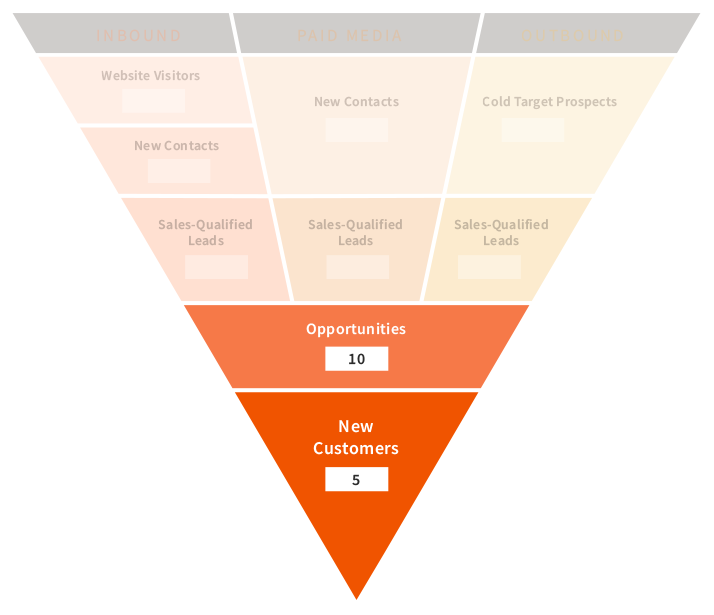
Let’s say your monthly new sales target is $500K. And your average sale with a new customer is worth $100K. Doing some simple math, your new customer goal will be 5 per month.
Moving North one section, we now have to identify how many new Opportunities (leads you’ve engaged in conversation who are actively considering your solution) will be required to meet that new customer target.
If your Sales team’s close rate is 50%, then you’ll need to produce 10 new Opportunities.
Now let’s jump way up to the top of the funnel.
The three ways to generate leads
For simplicity’s sake, we’ll assume there are three ways to fill the top of your funnel:
- Inbound
- Paid media
- Outbound
Collectively, these three streams in your funnel need to produce enough Sales-Qualified Leads (which we’ll refer to as “SQLs” for the remainder of this article) to reach your newly established target of 10 Opportunities per month.
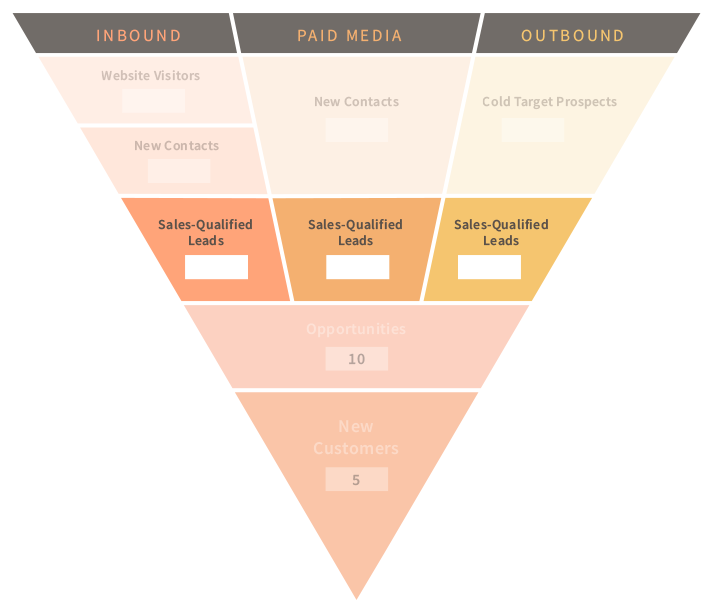
So how many total SQLs will you need?
Let’s say your Sales team is capable of engaging 25% of your SQLs in active buying conversations (converting them into Opportunities).
Under this assumption, your funnel will require:
- 40 total SQLs, in order to produce…
- 10 Opportunities, in order to produce…
- 5 new customers
With these targets established, let’s break down each of the three streams that will feed your funnel – so we can plan for where those 40 SQLs will actually originate.
The Left Stream: Inbound
Inbound is the logical starting place because we can benchmark your current state using existing website analytics data.
Let’s say:
- Your current unpaid website traffic is 3000 unique visitors per month
- 1% of those visitors are converting into new contacts through form submissions (30 new contacts/month)
- And 20% of those new contacts will actually be qualified leads (6 new SQLs/month)
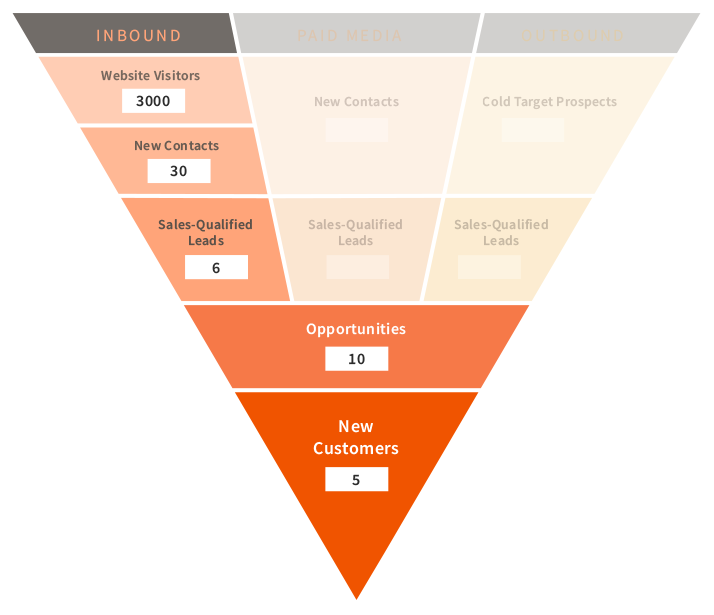
Having established that you’ll need to generate 40 SQLs (not 6), you’ll still need to account for 34. And those SQLs will come from some combination of the following:
- Investing more resources (time and/or money) in inbound
- Leveraging paid media
- Launching an outbound campaign
Say you start by making an investment in inbound. So you formulate a plan to begin crafting exceptional problem-solving, question-answering content on a regular basis, engage in smart SEO and social media strategies to amplify the visibility and reach of that content, and invest in conversion optimization on your website.
Through these initiatives, you aim to improve your inbound lead generation numbers so they look more like this:
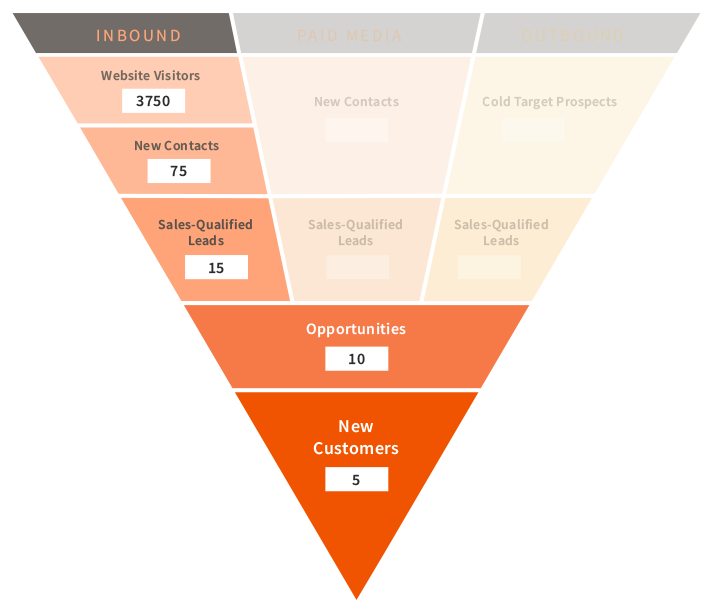
Although 15 SQLs are better than the original 6, you’re still well shy of the 40 you’re trying to produce in the short term.
This is where your other two streams in the top of your funnel come into play.
Let’s take a look.
The Middle Stream: Paid Media
Let’s say you commit some marketing dollars to LinkedIn ads and PPC (pay per click) – aiming to generate 60 new contacts per month, where 25% of them are qualified.

Now, between your Inbound and Paid Media streams you’ve accounted for 30 of the 40 SQLs required to reach your bottom-of-the-funnel goals.
The Right Stream: Outbound
This leads us to the third and final stream in your funnel: outbound.
To close the gap in this funnel and hit your target of 40 total SQLs per month, you still need to account for 10 SQLs.
But you’ll need to treat this third stream a little bit differently. Here’s why:
The SQLs you’ll produce through inbound and paid media will willingly take a step on their own (likely through a form submission on your website) to engage with you.
But with outbound, you’ll be the one proactively attempting to engage them. And because these prospects aren’t raising their hands, saying “I’m interested in what you’re talking about”, outbound will be a volume game (requiring a bigger pool of target prospects).
So your approach here is to define a segment of your audience and build a comprehensive list of as many target organizations (and specific buying-process influencers inside of those companies) as possible.
Then, you’ll design a joint Marketing-Sales blitz including tactics like cold email outreach sequences, phone calls, direct mail and maybe some other creative tactics as well to engage them.
For the sake of our example, let’s predict that 1 in 25 cold target prospects that you reach out to will become engaged enough to warrant the “SQL” label.
So you’ll target 250 individuals per month to meet your quota of 10 monthly SQLs from outbound.
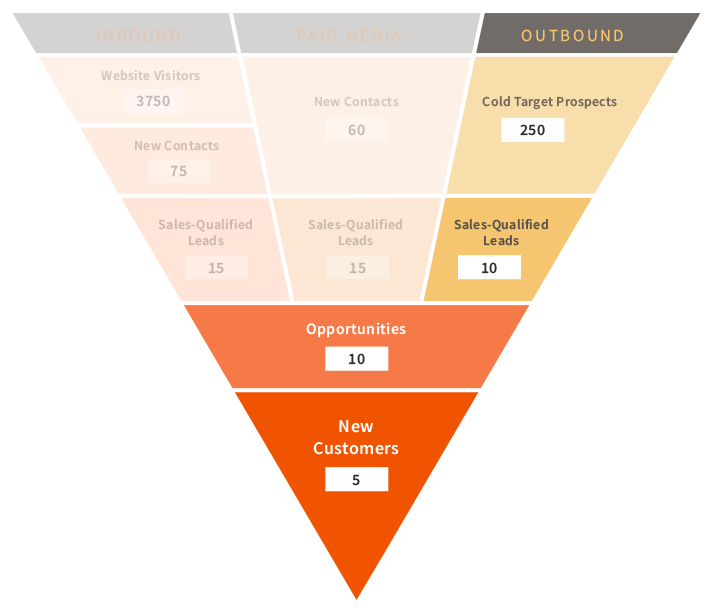
And with that, your funnel targets are in place:
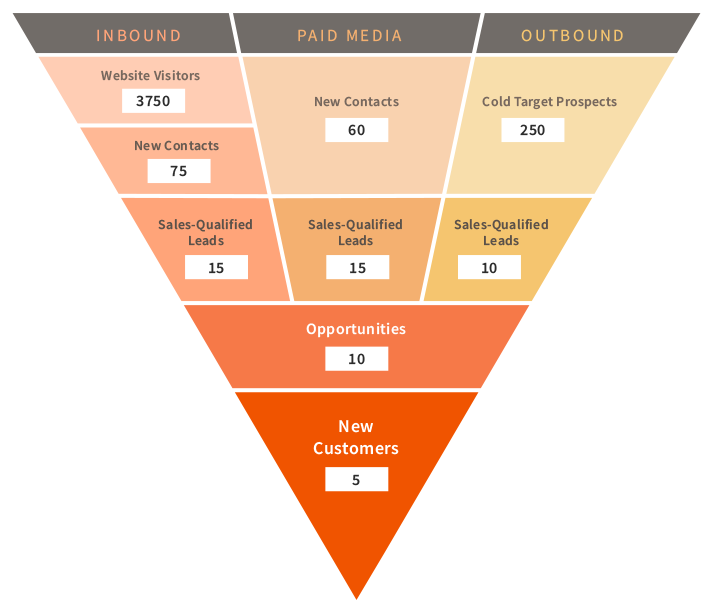
Rather than chasing a pie-in-the-sky customer acquisition target, you’ve now established leading KPIs (key performances indicators) inside a visual funnel to guide the formulation of your lead generation strategy and action plan.
Deciding where to invest
Earlier this year I published an article titled Fast Results vs. Sustainable Success: Take Your Pick.
So which matters more to you?
Fast results?
Or sustainable success?
It’s not a trick question. But it’s an important one to ask yourself, and here’s why:
If your inbound pipeline is currently weak, your competition online is heavy and you need to produce results quickly, inbound probably isn’t your answer.
Lead generation through inbound marketing is the result of a persistent effort to turn your website into an authoritative source of information for your audience.
In most cases, that simply takes time.
By no means should this be your excuse to avoid the inbound investment. Because in time, a well executed inbound strategy can be your most sustainable driver of leads.
My point is that you’ll likely need to temper your expectations about inbound results in the short term – with the understanding that you’re investing in the future of your business.
Paid media and outbound can usually get you where you need to go faster. But these efforts aren’t self sustaining. Unlike with inbound, when your budget runs dry, your lead generation results will follow suit.
If you’d like help planning your lead generation strategy, I encourage you to consider requesting a consultation. Here’s a snapshot of who we’re best at helping.